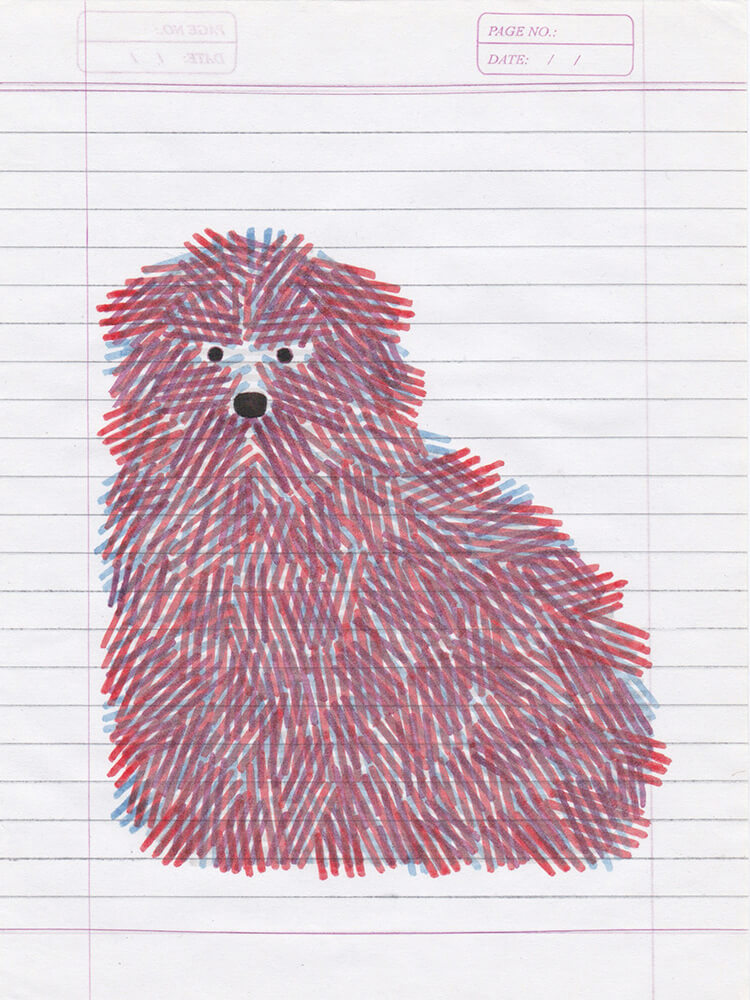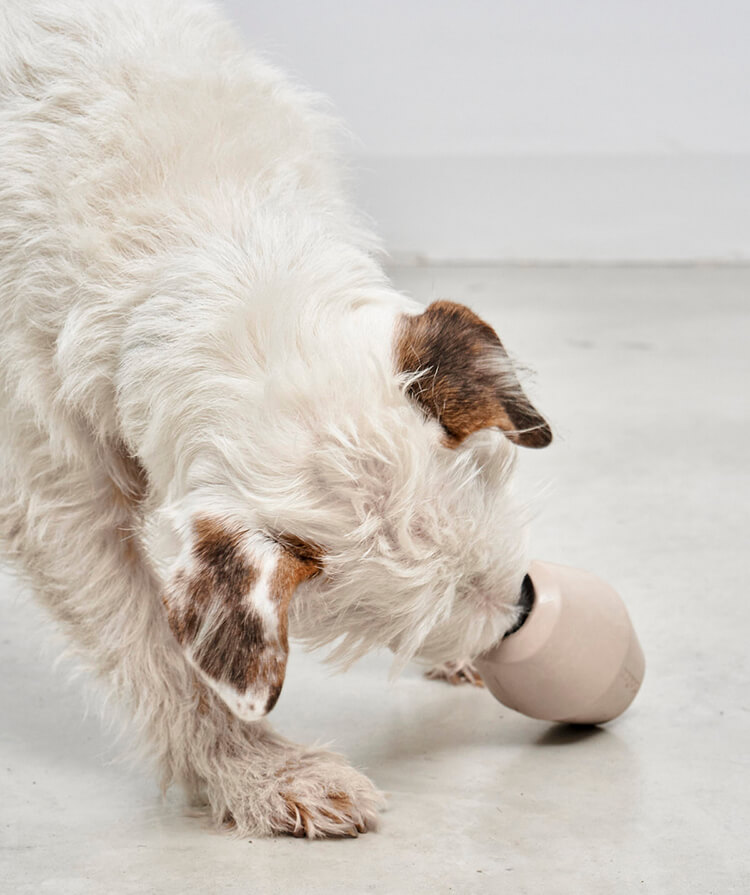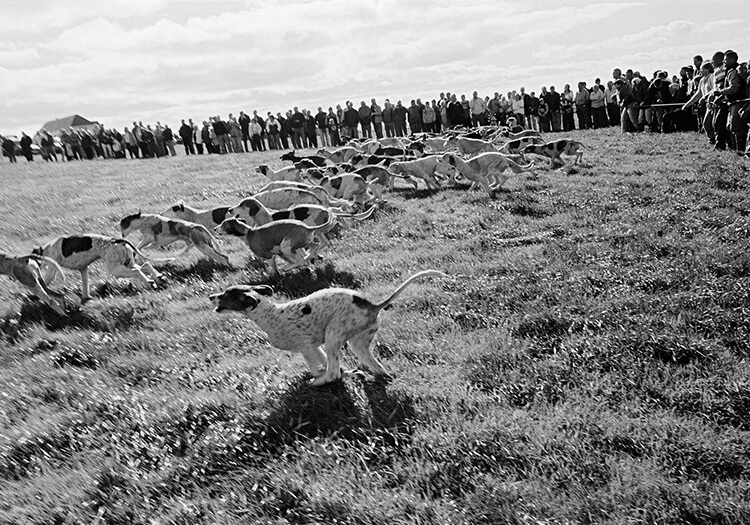
PUPPY PAINTINGS
For Brooklyn based artist Sophie Larrimore, dogs are not necessarily a point of interest in her practice: they are her practice.
s READ MORE
For Brooklyn based artist Sophie Larrimore, dogs are not necessarily a point of interest in her practice: they are her practice.
s READ MORESophie Larrimore focuses on larger, curly haired pups and, for the past few years, she has depicted them in cool colored scenes via acrylic and marker and watercolor. The works recall the colorful expressions of Fauvists from Henri Manguin to Orthon Friesz to even Henri Matisse: they observe the nature of these beautiful beasts, pushing them into loving abstraction to examine both their form and function in our lives.
To get an understanding of what goes into her work—which is currently on display at Portland’s Nationale through November 21—we spoke with Larrimore about her attraction to these animals, what Fauvism means today, and why dogs are to be taken seriously in art.
Dogs, frequently curly, poodle-ish pups, are often the subjects of your work. What draws you to them, in both your practice and in life?
Well, they make good subjects. The focus on the poodles has come about in the past few years. Prior to that I was still working with dogs, not a specific breed, but usually fluffy ones, they are more fun to paint. The most recent work has evolved from portrait type depictions to more general and stylised dog shapes. I used to look at a lot of pictures of dogs for reference, now I don’t look at any, I find it distracting and the results too literal, they are much better when just made up. Poodles are naturally anthropomorphic and that slightly human, slightly alien quality I find really beautiful.
Your paintings often depict dogs in play or investigating, in activities to be unpacked. Do you find that these canine figures represent or symbolise anything beyond the literal?
I certainly hope so. Though whatever those things are I would expect will be different depending on the viewer. I don’t come to the work with any direct narrative. Any ideas I may have about what is going on in each painting is merely a way to move the work forward and is never prescriptive, they are consistently changing as the work develops. In the end, if it is a successful painting, I am surprised by the result. The mark of a good painting is one which changes and reveals itself the longer you look.
Nude women frequently appear in your work in a visual dialogue with dogs. How are these two figures related, in your art and beyond?
It was somehow a natural pairing. There is an ambiguity and tension between the subjects that seems be come out in the work which I find intriguing. It is still evolving.
Your work has been described as Fauvist,a movement marked by colourful nature scenes adjacent to Impressionism. How do you see your practice continuing—or commenting on!—this movement?
The Fauvists used colour to push painting beyond the traditional model of realistic colour, using an over-saturated palette to suggest a deeper emotional state. That over-saturation is now just the state of our everyday lives. The challenge now is working with a lot of colour without making it arbitrary. I see my work in dialog with those painters in that I too am concerned with making a painting in which colour and form are just as important as subject.
As obvious as it sounds, why are dogs important to represent in art? Do you think the art world (and society in general) takes works featuring these animals seriously? Why or why not?
When I started painting dogs that was kind of the point, it was not a subject to be addressed seriously in painting, too naive, too saccharine, maybe too female. A great beginning. More recently the democratisation of subjects has really been embraced and now more than ever there is no subject really off limits. You are seeing more dogs represented in the Art World. There is perhaps still a tendency to approach them with a dose of irony. The work I make is certainly cheeky but I’m am not interested in making jokey paintings, funny paintings, not jokey. I’m more interested in engaging with the larger and richer painting dialog, which, at its most successful, will also address the broader society in which is it operating. Someone once asked if I was serious or not serious about my subject. It seems the goal of any painter should be both.
—
All artwork courtesy of Sophie Larrimore
sophielarrimore.com







We are thrilled to introduce Dog-Friendly, a collection of city guides for dog-loving people, created together with our long-time contributor, photographer Winnie Au, and fellow enthusiasts, indie publisher Hoxton Mini Press. Available for purchase here.
August 25, 2021

Have you ever imagined Amy Winehouse or Nick Cave as a Chihuahua, Neil Young as a Vizsla, or PJ Harvey as an Afghan hound? That’s exactly what San Francisco-based artist Michael Gillette has done through his unique illustration project, blending beloved, iconic music legends, both past and present, with their dog counterparts. Pack of Dogs, our first foray into book publishing, is a celebration of pup and pop culture for music and dog lovers alike.
August 25, 2020

Spanish photographer Sara Monsalve strives to ‘capture your memories’—to immortalise the beauty, innocence and wisdom of our pets.
November 8, 2023

French artist Jochen Gerner distils the magic and energy of dogs using disarmingly simple techniques, relying on felt pens and school notebooks.
November 3, 2023

Photographer Rebecca Rinaldi knows that to capture a dog’s true essence, play is the key ingredient.
July 13, 2023

An antidote to mass-produced dog accessories, MiaCara’s range of carefully crafted toys are designed to surprise, endure and delight.
July 12, 2023

Photographer Randal Ford’s fierce clarity draws dogs’ personality to the fore to reveal each animal’s “true essence”.
June 8, 2023

Moving your buddy from A to be B becomes an exercise in style, comfort and convenience with Cloud7’s Travel Collection.
June 2, 2023

In his series ‘Kinetic’, San Diego-based photographer James Lee celebrates dogs at full speed.
May 7, 2023

Jouk Oosterhof photographs Amsterdam’s beloved family members (with a dash of lifestyle accessory).
May 3, 2023

What started as a fundraising effort to save photographer Kristoffer Paulsen’s beloved dog Josie, morphed into Melbourne’s most in-demand pet portraits.
March 31, 2023

For decades, legendary Irish documentary photographer Tony O’Shea has captured the country’s annual drag hunt, and a country’s rich history along with it.
March 24, 2023
